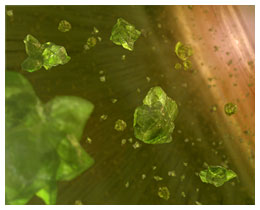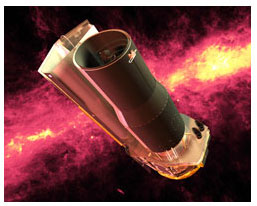PASADENA, Calif., Oct. 24 -- A NASA telescope has detected for the first time the building blocks of planets around brown dwarfs, suggesting that these much colder and dimmer cousins to stars probably also "sow the seeds" of planets. Until now, the microscopic crystals that eventually collide to form planets have only been seen around stars and comets -- considered to be the remnants of our solar system. 
Sowing the Seeds of Planets? This artist's concept shows microscopic crystals in the dusty disk surrounding a brown dwarf, or failed star. The crystals, composed of a green mineral found on Earth called olivine, are thought to help seed the formation of planets. (Image: NASA/JPL-Caltech/T. Pyle [SSC])
The infrared (IR) spectrograph on NASA's Spitzer Space Telescope recently spotted tiny crystals and dust grains circling six brown dwarfs ranging in mass from about 40 to 70 times that of Jupiter and roughly 1 to 3 million years old, located 520 light years away in the Chamaeleon constellation. The crystals, composed of a green mineral commonly found on Earth known as olivine, are thought to eventually crystallize and clump together to form planets. Brown dwarfs, like stars, form from thick clouds of gas and dust, but they collapse under their own weight. Astronomers believe planets were born out of these disks of dust that surround young stars and brown dwarfs. Spitzer has observed many of these disks, which glow at IR wavelengths. The observations imply that brown dwarfs might be good targets for future planet-hunting missions, although astronomers don't know if life could exist on planets around brown dwarfs.
The Spitzer Space Telescope (formerly SIRTF, the Space Infrared Telescope Facility) was named for the late Lyman Spitzer Jr., a renowned astrophysicist who was the first person to propose the idea of placing a large telescope in space and was the driving force behind the development of the Hubble Space Telescope. The Spitzer Space Telescope was launched on Aug. 25, 2003. During its two-and-a-half-year mission, Spitzer is obtaining images and spectra by detecting the IR energy, or heat, radiated by objects in space between wavelengths of 3 and 180 µm (1 µm is one-millionth of a meter). Most of this radiation is blocked by the Earth's atmosphere and cannot be observed from the ground. 
An artist's rendering of Spitzer against an infrared sky. (Image: NASA/JPL-Caltech)
Consisting of a 0.85-m telescope and three cryogenically-cooled science instruments, Spitzer is the largest IR telescope ever launched into space. Its highly sensitive instruments provide a unique view of the universe and allow scientists to peer into regions of space that are hidden from optical telescopes because they are filled with vast, dense clouds of gas and dust which block traditional viewing methods. IR light, however can penetrate these clouds, allowing scientists to peer into regions of star formation, the centers of galaxies and into newly forming planetary systems. IR also provides information about the cooler objects in space, such as smaller stars which are too dim to be detected by their visible light, extrasolar planets and giant molecular clouds. Also, many molecules in space, including organic molecules, have their unique signatures in the IR.
A paper on the Spitzer's findings appears in the journal Science. Authors of the paper include University of Arizona, Tucson, astronomers Daniel Apai and Ilaria Pascucci; Jeroen Bouwman, Thomas Henning and Cornelis P. Dullemond of the Max Planck Institute for Astronomy, Germany; and Antonella Natta of the Osservatorio Astrofisico di Arcetri, Italy.
NASA's Jet Propulsion Laboratory in Pasadena manages the Spitzer mission for NASA's Science Mission Directorate. Spitzer's infrared spectrograph, which made the observations, was built by Cornell University in Ithaca, N.Y.
For more information, visit: www.spitzer.caltech.edu